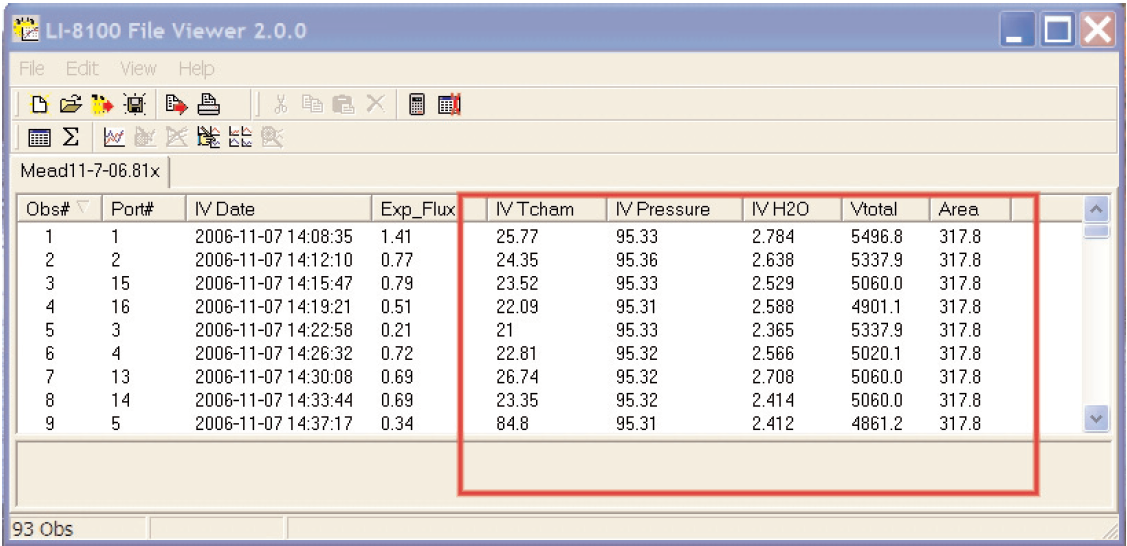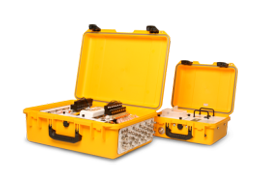Printable PDF: Overview of the Trace Gas Sampling Kit
(8100_AppNote_Collecting_Trace_Gas_Samples_08937.pdf)
Overview of the trace gas sampling kit.
Air samples can be collected from the same air stream used to measure soil CO2 flux with the LI-8100 Automated Soil CO2 Flux System, for estimating the flux of trace gas, such as methane (CH4), ammonia (NH3), nitrous oxide (N2O), isotopic species, etc. This application note describes a simple method for obtaining air samples from the LI-8100 in the field. The concentration of the gas species for those collected air samples can be subsequently analyzed with gas chromatography or mass-spectroscopy methods in a laboratory. The flux of the gas species can be estimated based on the rate of change of the gas species concentration inside the chamber and from information on other required variables, which can be obtained from the output file of the LI-8100.
Setup and taking air samples
Figure 1‑1 below shows a simple method for collecting air samples in the field. In this figure, the LI-8100 Analyzer Control Unit is connected directly to the 8100-103 Survey Chamber. A T-fitting with a septum is installed between the LI-8100 and chamber. Part number 8100-664 (available from LI-COR) is an accessory which allows the user to implement this method. The 8100-664 accessory is an assembled section of air line with a T-fitting and septum, and quick connectors at each end. This piece fits between the end of a chamber air line and the LI-8100 “Air In” port. This method can be used with all LI-8100 chambers without any modifications.

A 2-minute observation length is adequate for soil CO2 flux measurements, but for other trace gases, the observation length may need to be much longer due to their low flux rates. The observation length of the LI-8100 system can be set to any value. The appropriate observation length depends on how many trace gas samples are required and the time interval between them. Five to six samples during a period of 30 minutes may be sufficient for good curve fitting. The first air sample must not be taken until at least 20 s after the chamber is closed. Our experience suggests that good mixing in the system may not be established before 20 seconds have elapsed. When this air sampling method is used on our LI-8150 Multiplexer, the first air sample should be taken at least 30 seconds after the chamber is closed. Collected air samples can then be analyzed with gas chromatography or mass spectroscopy methods in the laboratory.
Data analysis
Depending on the behavior and shape of the time series data, the rate of change of the trace gas concentration (∂S/∂t) inside the chamber can be estimated with either a linear regression or an exponential curve fit as described in the LI-8100 User Manual, or e.g. de Mello and Hines (1994). If using an exponential curve fit, we suggest you estimate ∂S/∂t at t = 0, considering t = 0 as the time when the first trace gas sample was taken. After obtaining ∂S/∂t, the flux is then calculated using the following equation:
where W0 is the initial water vapor mole fraction (mmol mol-1), T0 is initial air temperature (°C). V is total system volume (cm3), P0 is the initial pressure (kPa), A is soil surface area (cm2), R is the gas constant (8.314 Pa m3 K-1mol-1). See LI-8100 Manual for further explanation.

After downloading the LI-8100 data file onto a computer, values for variables To, Po, Wo, V, and A can be conveniently obtained using the SoilFluxPro Software. These variables are labeled as IV Tcham, IV Pressure, IV H2O, Vtotal, and Area. Tcham, IV Pressure, and IV H2O are in the group of Measured Variables. Vtotal and Area can also be exported into a text file for the flux calculation.
If the units for trace gas concentration are μmol mol-1 or ppm, then the final units for flux will be μmol m-2 s-1. If the units are nmol mol-1 or ppb, then flux will have the units of nmol m-2 s-1. Since the LI-8100 is a closed-chamber system, removing air samples from the system will cause an error in the soil trace gas flux estimation. The following analysis demonstrates that the error is negligible if a few small, discrete air samples are removed from the chamber during flux measurements.
A CO2 flux measurement is shown here as an example and a chamber volume of 5 liters is assumed. Removing a 10 cm3 air sample from the chamber will create a very minor change in chamber CO2 concentration. If we assume the chamber headspace has a CO2 concentration of 450 μmol mol-1 and the removed air is refilled with ambient air having a CO2 concentration of 370 μmol mol-1, then the chamber CO2 concentration will decrease by only 0.16 μmol mol-1 to 449.84 μmol mol-1.
Therefore, removing a few small air samples during a measurement will have a negligible effect on flux measurements.
For further information, contact LI-COR at 1-800-447-3576, or envsupport@licor.com.
References
| 1 | de Mello, W. Z., Hines, M. E., 1994. Application of static and dynamic enclosures for determining dimethyl sulfide and carbonyl sulfide exchange in Sphagnum peatlands: Implications for the magnitude and direction of flux. Journal of Geophysical Research, 99: 14,601- 14,607. |
